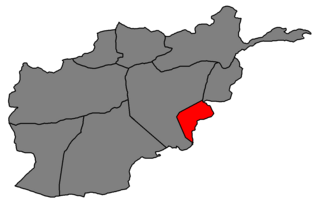 W
WThe 1979 Herat uprising was an insurrection that took place in and around the city of Herat, Afghanistan in March 1979. It included both a popular uprising and a mutiny of Afghan Army troops against the Democratic Republic of Afghanistan (DRA). The communist regime at first appealed to its Soviet allies for help, but the Soviet leadership declined to intervene. After the insurgents seized and held the city for about a week, the regime was able to retake it with its own forces, and the subsequent aerial bombardment and recapture of Herat left up to 25,000 of its inhabitants dead.
 W
WThe Afghan tribal revolts of 1944–1947 or the Khost disturbances were a series of tribal revolts in the Kingdom of Afghanistan by Zadran, Safi and Mangal tribesmen which lasted from February 1944 to January 1947. The causes of the revolts laid in the worsening conditions of farmers, changes in conscription laws, the elimination of the power of Safi tribal leaders, Amanullah loyalism, trading monopolies, government surveillance, taxation, and poverty. The conflict began when government forces clashed with the forces of a tribal leader named Mazrak, who led the Zadran tribe in revolt. The Zadran uprising was followed by additional uprisings by the Safi and Mangal, the former of which elected their own king, Salemai. Faqir Ipi, a tribal leader from Waziristan, also fought for the restoration of former king Amanullah Khan alongside other rebels.
 W
WThe Alizai rebellion of 1923 was a rebellion by the Alizai tribe in the region of Zamindawar, in modern-day Helmand Province of the Emirate of Afghanistan, which took place in 1923. The causes laid in opposition to the reforms of Amanullah Khan, namely in regards to conscription and taxation. The rebellion lasted 6 months, largely due to the fact that none of the conscripted battalions in the south were willing to fight the Alizai. Ultimately, the rebellion was defeated with troops from Herat, who executed rebel leaders and deported groups of Zamindawaris to Afghan Turkestan.
 W
WAmanullah loyalism refers to several historical movements in the Kingdom of Afghanistan to restore Amanullah Khan as king of Afghanistan after he was deposed in January 1929 during the Afghan Civil War. Loyalists were sometimes referred to as Amanite. Loyalists tried to achieve this in various ways, including armed rebellions, political parties, colluding with foreign powers and assassinations. These movements were unsuccessful, and Amanullah died in exile in 1960 in Zürich, Switzerland without ever regaining control, other than a brief period of control in southern Afghanistan in the 1929 Afghan Civil War.
 W
WThe 2001 uprising in Herat was a coordinated insurrection and uprising in the Afghan city of Herat as part of the United States war in Afghanistan. The city was captured on November 12 by Northern Alliance forces as well as Special Forces of the United States, the United Kingdom and the Islamic Republic of Iran.
 W
WThe Khost rebellion, also known as the 1924 Mangal uprising, the Khost revolt or the Mangal Revolt was an uprising against the Westernization and modernizing reforms of Afghanistan’s king, Amanullah Khan. The uprising was launched in Southern Province, Afghanistan, and lasted from March 1924 to January 1925. It was fought by the Mangal Pashtun tribe, later joined by the Sulaiman Khel, Ali Khel, Jaji, Jadran and Ahmadzai tribes. After causing the death of over 14,000 Afghans, the revolt was finally quelled in January 1925.
 W
WAmanullah loyalism refers to several historical movements in the Kingdom of Afghanistan to restore Amanullah Khan as king of Afghanistan after he was deposed in January 1929 during the Afghan Civil War. Loyalists were sometimes referred to as Amanite. Loyalists tried to achieve this in various ways, including armed rebellions, political parties, colluding with foreign powers and assassinations. These movements were unsuccessful, and Amanullah died in exile in 1960 in Zürich, Switzerland without ever regaining control, other than a brief period of control in southern Afghanistan in the 1929 Afghan Civil War.
 W
WThe Kuhistan rebellion was a rebellion by the Saqqawists in modern-day Kohistan District, Kapisa Province which took place in July 1930 in the Kingdom of Afghanistan. The rebellion, which was led by Purdil Khan, an uncle of the former king of Afghanistan, Habibullāh Kalakāni, was crushed within a week. After the rebellion was suppressed, 3000 of the rebels were captured and 11 of the ringleaders were executed, while the rest were allowed to go home and "follow some honest pursuit". Purdil was killed during the fighting.
 W
WAmanullah loyalism refers to several historical movements in the Kingdom of Afghanistan to restore Amanullah Khan as king of Afghanistan after he was deposed in January 1929 during the Afghan Civil War. Loyalists were sometimes referred to as Amanite. Loyalists tried to achieve this in various ways, including armed rebellions, political parties, colluding with foreign powers and assassinations. These movements were unsuccessful, and Amanullah died in exile in 1960 in Zürich, Switzerland without ever regaining control, other than a brief period of control in southern Afghanistan in the 1929 Afghan Civil War.